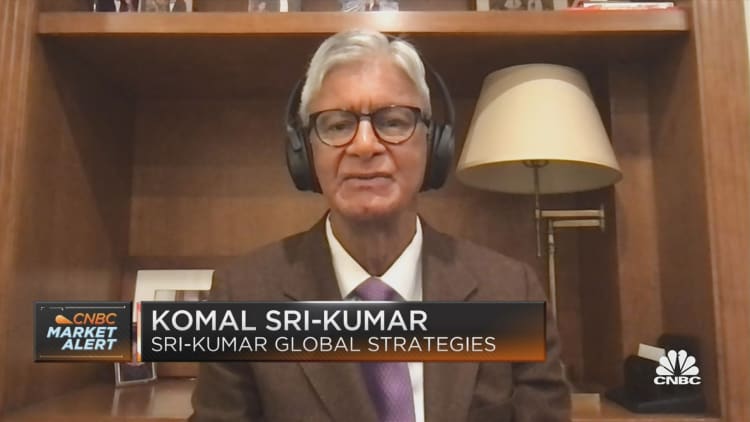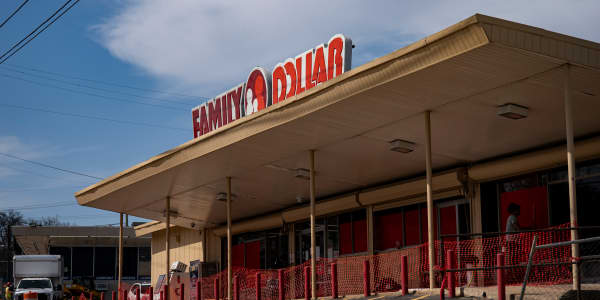With as much as 60% of U.S. consumers living paycheck to paycheck, it's not a surprise to see that the spending cutbacks have started. Even with a strong job market and wage gains, as well as Covid stimulus savings, price spikes in core spending categories including food, gas and shelter are leading more Americans to mind their pocketbooks closely.
A new survey from CNBC and Momentive finds rising concerns about inflation and the risk of recession and Americans saying that not only have they started buying less but that they'll buy less across more categories if inflation persists. But these financial stress points are not limited to lower-income consumers. The survey finds Americans with incomes of at least $100,000 saying they've cut back on spending or may soon do so in numbers that are not far off the decisions being made by lower-income groups.
The high-income consumer demographic is key to the economy. While it represents only one-third of consumers, it is responsible for up to three-quarters of the spending. "If the high-income consumers are out buying, we won't see a big impact on raw consumer activity," said Mark Zandi, chief economist at Moody's.
Lower-income households are the most at risk, and they are the ones most likely to be making unwelcome tradeoffs to make their money stretch as far as it did just a few months ago, according to the survey results. They are also clearly experiencing more financial anxiety, according to the survey, with 57% of Americans with income under $50,000 saying they are under more stress than a year ago, versus 45% of those with incomes of $100,000 or more. The 68% of high-income consumers who said they are worried higher prices will force them to rethink financial decisions is significantly lower than the 82% of Americans with income of $50,000 or less who told the survey this, but it is still a majority.

More than half of people with household incomes under $50,000 say they have already cut back on multiple expenses due to prices, and for those with income of at least $100,000, the cutback levels are already similar when it comes to dining out, taking vacations, and buying a car.
"People making six-figure incomes are almost as worried about inflation as people making half as much —and they are just as likely to be taking steps to mitigate its effect on their lives," said Laura Wronski, senior manager of research science at Momentive. "Inflation is a problem that compounds over time, and even high-income individuals won't be insulated from the second- and third-order effects of price increases."
Other recent consumer survey data paints a weakening picture.
The University of Michigan Survey of Consumers finds more consumers mentioning reduced living standards due to rising inflation than at any other time in the survey's history except during the two worst recessions in the past 50 years: from March 1979 to April 1981 and from May to October 2008. Notably, the consumer confidence gap between low- and high-income levels always shrinks at cyclical troughs and is always widest at peak, and the gap is narrowing now, according to survey director Richard Curtin.
In January, the percentage point gap between the lowest-income group and highest-income group in the survey's sentiment index was 13.2 points. That was erased in March, with the top-income group sentiment actually dipping below the lowest-income bracket in overall sentiment and future expectations. In January, the higher-income group expectations, specifically, were 18 percentage points higher.
Right now, there is a unique set of issues that could be exacerbating this gap narrowing, Curtin said, including the potential for Russia's invasion of Ukraine to do more damage to the global economy than forecast and the fact that the majority of the population has not experienced 10%+ inflation, or 15% mortgage rates, as past generations had.
"Even at lower rates they may display behaviors associated with more extreme economic conditions in the past," Curtin said. "Precautionary motives play a big part in consumption trends for upper income groups."
"The American consumer is in a dark mood," Zandi said of the CNBC survey data. It's been more than two years since the pandemic hit, first with millions of lost jobs and high unemployment, and now high inflation, and "fractured politics also weighing heavily on the collective psyche."
All income groups in the survey are equally likely to say the economy will enter a recession this year, at over 80%. But there is a key caveat: Spending actions from the economy don't yet indicate this prediction will come true.
Despite the downbeat feelings about their financial situations, and the cutbacks, consumers are still spending strongly, Zandi emphasized. There are now lots of jobs, unemployment is low, debt loads are light, asset prices are high, and there is a lot of excess saving. Even if people are cutting back, spending less on some items, the mood has not yet taken control of the spending motivation to a degree that amounts to more than a slowdown in economic growth. "I suspect the American consumer will continue spending, regardless of their mood, as long as the job market remains strong," Zandi said.
The Conference Board's latest monthly confidence index reading showed present confidence up, though slightly, for the first time this year, but the expectations index lower, with consumers citing rising prices, including gas.
Lynn Franco, director of economic indicators and surveys at The Conference Board, said there is still a gap in its confidence data between lower-income and higher-income consumers and a lot of that is driven by the inflationary environment and less impact the affluent will feel from factors including gas prices. She said the gap does always narrow in a prerecession period — but its data is not indicating a recession as of now.
What its confidence survey is forecasting is a slowdown in growth over the next few quarters driven by higher prices, and more Americans spending less on discretionary items as more of their money goes to covering the basics. That will be most acutely felt by the lower-income consumers, but there is broad-based concern about prices rising significantly in the months ahead — 6 out of every 10 consumers surveyed by The Conference Board think the Russia-Ukraine war will cause prices to rise significantly.
"That is very broad-based and that, coupled with interest rates going up, may make people more hesitant to postpone big-ticket purchases like housing and autos and washing machines," Franco said. "We will see a bit of slowing in consumer spending over the next few quarters, but we don't feel that will drive us into recession."
The overall confidence level from Americans with income of $125,000 in its survey has come back down from mid-2021, but Franco described them as still "relatively confident despite all volatility we have seen. ... The indications we are getting across income groups speaks more towards softening in consumer spending rather than a severe pullback."
The Conference Board data, similar to other outlooks, is underpinned by a key role for the labor market in supporting confidence and balancing the negative influence of inflation, with Americans who say jobs are "plentiful" at an all-time high.
Members of the CNBC CFO Council have mentioned "a tale of two cities" among consumers, with higher-income consumers continuing to be strong while lower-income consumers are beginning to chew through the stimulus. There will be a new equilibrium point, and inflation won't grow as it has over the past year, but it will remain at a higher level, and the consumer spending has to be set against this dynamic that will play out through calendar year 2022, and is expected to be more sharply felt in the second half of the year.
Key factors that CFOs are watching include the decline in the consumer savings rate; how successful the Fed is in using its tools to slow the economy without pushing it into recession, including raising rates to cool consumption and investment; and greater supply chain stability.
The supply chain remains in flux with new Covid variants, as well as the Russian war against Ukraine hitting energy and food prices. But if supply chain pressures overall do ease, inventory will be replenished at a rate that could lead to more pushback from retailers on pricing, as consumers also begin to slow their consumption habits, trading down in certain categories of purchases or trading away from them.
The Conference Board's most recent CEO survey showed that companies are passing along the costs of inflation relatively quickly to consumers, and that pattern is likely to continue in the months ahead, with wage gains a contributing factor. "What we are seeing and hearing from members is that these tight labor market conditions are going to continue for several months, so we will continue to see wage pressure," Franco said.
As earnings come in, the market will be looking for signs of durable consumer strength amid higher prices. Earlier this week, Conagra's results showed that it couldn't make price increases flow through to its bottom line relative to input costs, but CEO Sean Connolly said Thursday that "consumer demand has remained strong in the face of our pricing actions to date."
Conagra is planning more price increases.






